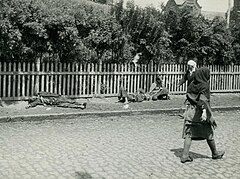
Back Holodomor Afrikaans هولودومور Arabic Holodomor AST Qolodomor Azerbaijani Украиналағы аслыҡ (1932—1933) Bashkir Галадаморы (Украіна) Byelorussian Галадамор ва Ўкраіне BE-X-OLD Гладомор Bulgarian Holodomor Breton Holodomor BS
| Holodomor Голодомор | |
|---|---|
 Starved peasants on a street in Kharkiv, 1933, Ukraine's capital at the time | |
| Country | Soviet Union |
| Location | Soviet Ukraine, northern Kuban,[1] Kazakhstan |
| Period | 1932–1933 |
| Total deaths |
|
| Causes |
|
| Relief | Foreign relief rejected by the state. 176,200 and 325,000 tons of grains provided by the state as food and seed aids between February and July 1933.[5] |
| Effect on demographics |
|
| Consequences |
|
The Holodomor,[a] also known as the Ukrainian Famine,[9][b] was a man-made famine in Soviet Ukraine from 1932 to 1933 that killed millions of Ukrainians. The Holodomor was part of the wider Soviet famine of 1930–1933 which affected the major grain-producing areas of the Soviet Union.
While scholars are in consensus that the cause of the famine was man-made,[10][11] whether the Holodomor constitutes a genocide remains in dispute. Some historians conclude that the famine was deliberately engineered by Joseph Stalin to eliminate a Ukrainian independence movement.[c] Others suggest that the famine was primarily the consequence of rapid Soviet industrialisation and collectivization of agriculture. A middle position, held for example by historian Andrea Graziosi, is that the initial causes of the famine were an unintentional byproduct of the process of collectivization but once it set in, starvation was selectively weaponized and the famine was "instrumentalized" and amplified against Ukrainians to punish them for their rejection of the "new serfdom" and to break their nationalism.[12]
Ukraine was one of the largest grain-producing states in the USSR and was subject to unreasonably high grain quotas compared to the rest of the USSR.[d] This caused Ukraine to be hit particularly hard by the famine. Early estimates of the death toll by scholars and government officials vary greatly. A joint statement to the United Nations signed by 25 countries in 2003 declared that 7 to 10 million died.[e] However, current scholarship estimates a range significantly lower with 3.5 to 5 million victims.[13] The famine's widespread impact on Ukraine persists to this day.
Since 2006, the Holodomor has been recognized by Ukraine and 33 other UN member states, the European Parliament, and 35 of the 50 states of the United States[14] as a genocide against the Ukrainian people carried out by the Soviet government.
- ^ Naimark 2010, p. 70.
- ^ Osadchenko & Rudneva 2012.
- ^ Boeck, Brian J. (30 October 2023). "Complicating the National Interpretation of the Famine: Reexamining the Case of Kuban". Harvard Ukraine Studies. 30 (1/4): 48. JSTOR 23611465.
- ^ a b Ohayon 2016.
- ^ Davies & Wheatcroft 2004, pp. 479–484.
- ^ a b Ellman 2007.
- ^ Deutsche Welle, Dec 2022.
- ^ Jones 2017, p. 90.
- ^ "How Joseph Stalin Starved Millions in the Ukrainian Famine". HISTORY. 16 April 2019. Retrieved 13 February 2024.
- ^ Andriewsky 2015, p. 37: "Historians of Ukraine are no longer debating whether the Famine was the result of natural causes (and even then not exclusively by them). The academic debate appears to come down to the issue of intentions, to whether the special measures undertaken in Ukraine in the winter of 1932–33 that intensified starvation were aimed at Ukrainians as such."
- ^ Rozenas, Arturas; Zhukov, Yuri M. (2019). "Mass Repression and Political Loyalty: Evidence from Stalin's 'Terror by Hunger'". American Political Science Review. 113 (2): 571. doi:10.1017/S0003055419000066. S2CID 143428346.
Similar to famines in Ireland in 1846–1851 (Ó Gráda 2007) and China in 1959–1961 (Meng, Qian and Yared 2015), the politics behind Holodomor have been a focus of historiographic debate. The most common interpretation is that Holodomor was 'terror by hunger' (Conquest 1987, 224), 'state aggression' (Applebaum 2017) and 'clearly premeditated mass murder' (Snyder 2010, 42). Others view it as an unintended by-product of Stalin's economic policies (Kotkin 2017; Naumenko 2017), precipitated by natural factors like adverse weather and crop infestation (Davies and Wheatcroft 1996; Tauger 2001).
- ^ Werth 2008.
- ^ Gorbunova & Klymchuk 2020; Kravchenko 2020; Marples 2007, p. 1; Mendel 2018; Yefimenko 2021
- ^ "Wyoming becomes 32nd US state to recognize the Holodomor as genocide". The New Voice of Ukraine. Retrieved 13 November 2023.
Cite error: There are <ref group=lower-alpha> tags or {{efn}} templates on this page, but the references will not show without a {{reflist|group=lower-alpha}} template or {{notelist}} template (see the help page).